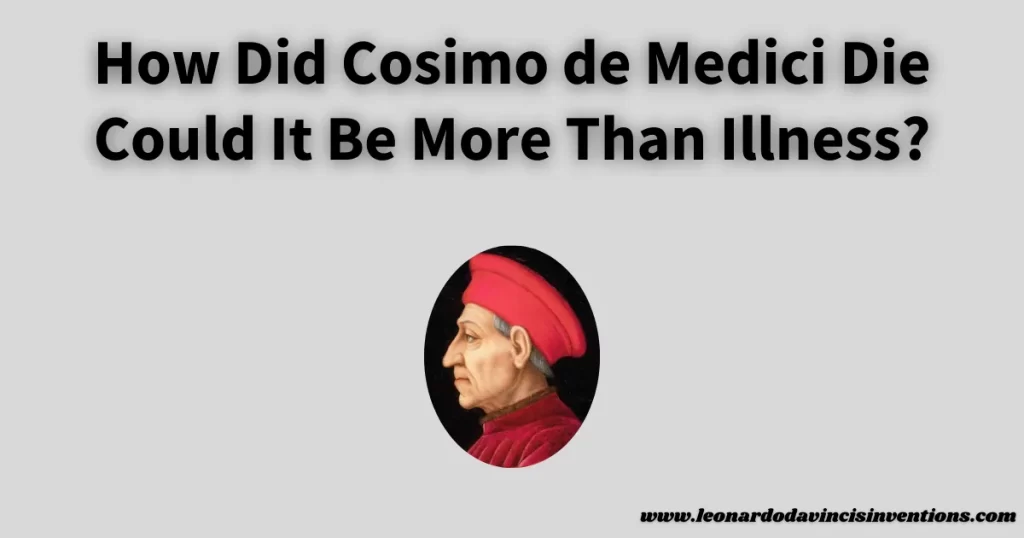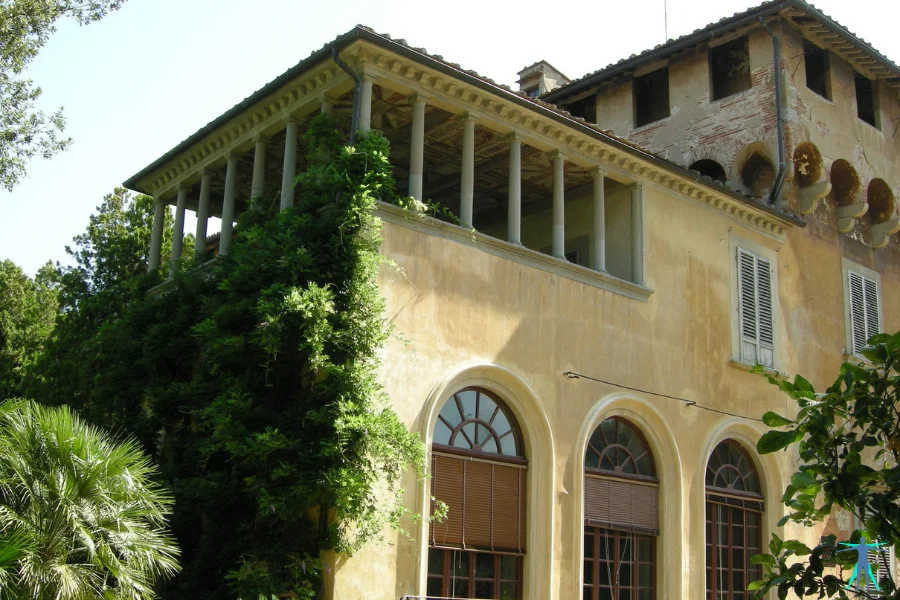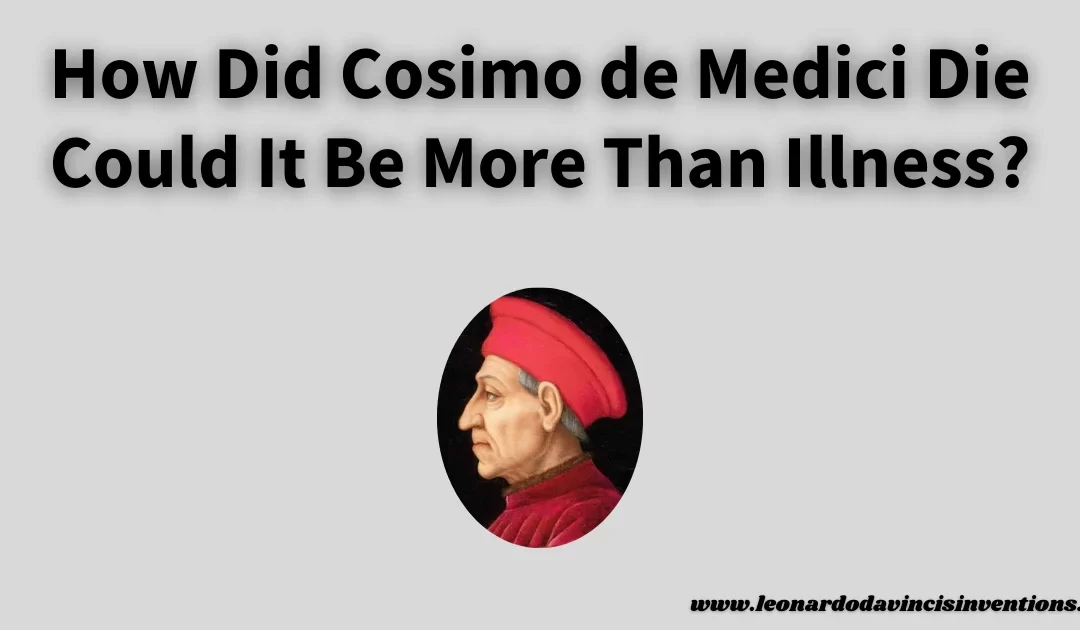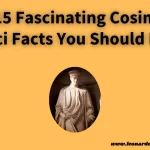
How did Cosimo de’ Medici die is a question historians and curious minds have explored for centuries.
You may wonder if there is more to his death than just natural illness, and whether political intrigue or hidden motives played a part.
Cosimo de’ Medici, the founder of the Medici family’s power, died in 1464, and most sources agree that it was old age and gout. There is no substantial evidence pointing to foul play.
His later years were marked by both declining health and constant political challenges. By examining documents and accounts from his time more closely, you can gain a deeper understanding of what life was like for Cosimo and uncover the details of his health issues.
Rumors of conspiracy have followed his legacy. For anyone curious about the history of Florence, his story combines medical facts with the mysteries of Renaissance politics.
The Life and Legacy of Cosimo de’ Medici Before His Death
Cosimo de’ Medici shaped the Renaissance in Florence through banking, politics, and cultural support. His actions created a legacy that set the stage for the Medici dynasty’s power and wealth, profoundly changing Florentine society.
Cosimo de’ Medici’s Role as a Banker and Politician in Renaissance Florence
Cosimo de’ Medici began as a successful banker and went on to become a leading politician in Florence. As the head of the Medici bank, he created a network of branches across Europe and handled the finances of popes, royalty, and merchants.
This made the Medici house one of the wealthiest and most influential families in Renaissance Italy. In addition to finances, Cosimo held political power.
He guided Florence behind the scenes, using his wealth to influence elections and city policies. Historical records show he avoided direct titles and preferred quiet control to open rule.
This strategy kept him safe from enemies and allowed him to maintain stability throughout his life.
The Rise of the Medici Family and Their Impact on Florentine Society
The Medici family’s rise transformed Florence into a hub of economic growth and culture. Under Cosimo’s guidance, the family’s fortune enabled major public works, artistic commissions, and charitable projects.
Their actions brought jobs and prosperity to the city, strengthening their popularity among citizens. Cosimo’s leadership also brought stability during periods of political and social trouble.
He supported laws that helped merchants and the working class, separating his family from wealthy houses. The Medici legacy in art and politics was rooted in these early efforts to link wealth with public benefit.
Cosimo’s Influence as a Patron of the Arts and Cultural Patronage
A key part of Cosimo’s legacy is his support for painters, sculptors, writers, and architects. He sponsored artists like Donatello and Fra Angelico and encouraged the building of key landmarks such as the San Lorenzo Church.
Cosimo saw cultural patronage as a means to uplift Florence and leave a lasting mark on the Medici name. Cosimo’s investments paved the way for the Renaissance to flourish in the city.
Through his support, Florence became a center for learning and creativity, attracting scholars from across Europe. These acts reflect Cosimo’s view that power and influence could advance art and science for the greater good.
The Power and Wealth Behind the Medici Dynasty and Political Leadership
The Medici dynasty’s wealth was unmatched, mainly from the Medici banking empire. This allowed Cosimo to fund alliances and secure his family’s political leadership.
His approach blended careful diplomacy with favors and loans to important groups and leaders. Cosimo kept Florence out of dangerous wars during his rule and promoted trade.
His style of leadership became a standard for later Florentine rulers. Cosimo’s discreet influence and strong finances protected the city from chaos and set the stage for the Medici to become Grand Dukes of Tuscany.
Succession and the Medici Lineage After Cosimo’s Death
According to historical accounts, Cosimo de’ Medici died in 1464 at the age of 75 at his Careggi villa. He died most likely from natural causes and old age after years of health problems, including gout and arthritis. His funeral procession in Florence was large and showed the deep respect he earned from citizens and leaders.
After his death, Cosimo’s son Piero took over leadership, beginning the next stage of the Medici lineage. The Medici family faced challenges but kept its strong link to Florence’s political life and arts for many years.
Examining the Death of Cosimo de’ Medici in 1464

Cosimo de’ Medici died in 1464 at the age of 75, leaving a major impact on Florence and the Medici dynasty. His last days, cause of death, and reaction from Florentine society show how central he was to the city’s Renaissance power and political stability.
Historical Records and Death Timeline of Cosimo de’ Medici at Age 75
Historical records indicate that Cosimo di Giovanni de’ Medici, the founder of the Medici family’s fortune and a key political leader, passed away on August 1, 1464, at the age of 75. Chroniclers like Giovanni Cavalcanti carefully noted the final months before Cosimo’s death.
His declining health started several years earlier, possibly due to chronic illnesses common among his family. Joint pains, especially gout, were documented.
The Medici family closely monitored these health declines to prepare for the impending succession. Cosimo’s death marked a significant transition for Florence and the Medici lineage.
Careggi Villa: The Location and Circumstances of Cosimo’s Death
Cosimo died at the family’s Careggi villa, a country residence outside Florence. Unlike some later Medici rulers, he spent his last days away from the city center.
The villa provided a quiet space during illness and was often used by the Medici family for retreat and convalescence. Careggi had a reputation as a place of learning and discussion, where Cosimo hosted Renaissance thinkers and artists.
Friends, family, and important advisors gathered around him in his last hours. This private setting highlighted the personal side of a man best known for his roles as a banker, arts patron, and political figure.
The location shaped both his final days and the Medici legacy that followed. This History Today article provides an overview of Careggi’s significance.
Natural Causes or Illness? The Official Cause of Death According to Historical Accounts
Contemporary accounts agree that Cosimo’s death was due to natural causes, but health conditions played a major role. Chronic gout, arthritis, and bladder problems were frequently mentioned in diaries and letters.
According to modern historians, these conditions likely contributed to Cosimo’s gradual decline in health. No evidence suggests that violence or political intrigue is involved.
His death was attributed to the effects of age and the illnesses that came with it.
Funeral Procession and the Public Reaction in Florence
After his death, Cosimo’s body was carefully transported from Careggi to the Church of San Lorenzo in Florence. His funeral became a major event in the city, drawing crowds along the procession route.
Contemporary observers noted signs of genuine mourning, reflecting his broad impact as a statesman and patron. Florentine society respected Cosimo’s political leadership and his role in supporting art, architecture, and learning.
The Medici dynasty’s power and influence became even more apparent during the funeral, when elites and ordinary people gathered to honor the man often referred to as “Pater Patriae”—Father of the Fatherland.
Old Age and Its Role in the Death of the Florentine Ruler
Cosimo’s age played a decisive role in his passing. Living to 75 in Renaissance Italy was unusual, as many rulers fell to violence, disease, or exile.
Cosimo outlived most political rivals and family members, which made his aging process closely watched by Florentine society. Old age brought health challenges, but it also highlighted Cosimo’s longevity as a person and leader.
Unlike other Florentine rulers who died young or under suspicious circumstances, Cosimo’s death stood out for its quiet, natural decline.
Theories and Controversies Surrounding How Cosimo de Medici Died
Cosimo de Medici died in 1464 at the Careggi villa on the outskirts of Florence. He had been a banker, a politician, the founder of the Medici dynasty, and a major patron of the arts.
He exerted enormous influence over Renaissance Italy and Florentine society.
Alternative Cause of Death Theories Beyond Natural Causes and Illness
Cosimo de’ Medici died at the age of 75, which was considered an advanced age in the fifteenth century. According to most historical records, his death was due to natural causes, specifically old age, compounded by illnesses such as gout, arthritis, and bladder problems.
Some later accounts and rumors raised the possibility of poisoning or foul play, perhaps by rivals hoping to seize the Medici fortune or influence. However, there is no substantial evidence to support these allegations.
The prevailing consensus is that Cosimo’s declining health was typical for someone of his status and age at that time. Modern studies of the Medici family’s medical history further support the conclusion that their deaths were natural.
Political Exile and Medici Family Decline in Contrast to Cosimo’s Death
Unlike other Medici family members, such as Francesco I de’ Medici, whose deaths led to speculation of political exile, conflict, or even malaria, Cosimo’s death did not result from sudden violence or dramatic political upheaval.
Cosimo had experienced political exile earlier in his life.
In his later years, he firmly controlled Florence as its leading statesman.
After Cosimo’s passing, the Medici family suffered a significant decline during political instability and exile.
The Impact of Cosimo’s Death on Medici Dominance and Political Stability in Renaissance Italy
Cosimo de’ Medici’s death marked a turning point in the Medici dynasty’s hold over Florence and Renaissance Italy.
His political leadership created a stable government, balanced power among Florence’s major families, and supported the success of the Medici banking empire.
The city publicly mourned his passing with a long funeral procession and widespread grief.
After his death, Florence faced uncertainty as his successors struggled to match his diplomatic skills and consensus-building abilities.
This led to political challenges within Florence, and the Medici’s grip on power temporarily weakened.
How Cosimo’s Death Influenced the Legacy of the Medici House and Florence’s Future
Cosimo’s death set in motion significant changes within the Medici house and Florentine society.
Cosimo, the founder of the Medici dynasty and a leading figure in cultural patronage, shaped the city’s artistic identity and political landscape.
His investments in art, architecture, and education fostered a golden age of creativity in Florence.
After his death, the Medici family’s legacy as patrons of the arts continued.
Internal family struggles and challenges from outside powers made their dominance less specific.
Uncovering Clues from Historical Accounts and Medici Dynasty Records
Historical accounts from the time of Cosimo’s death describe a solemn atmosphere, noting the deceased’s age, illnesses, and stature.
Contemporary chroniclers recorded the event precisely, noting the location at the Careggi villa and the importance attached to the funeral.
Records from the Medici dynasty show that Cosimo’s health had been failing for years, frequently mentioning his struggles with gout and other ailments.
Archival evidence and eyewitness reports strongly support that he died from natural causes at age 75.
These records help clarify the circumstances and dismiss unfounded theories of the cause of death.
Frequently Asked Questions
Cosimo de’ Medici played a pivotal role in Florence’s early Renaissance history.
His life, health, and succession raised essential questions about the Medici family’s power and legacy.
What happens to Cosimo Medici?
Cosimo de’ Medici led Florence through a period of political and economic stability.
He shaped its government, funded the arts, and gained respect as a statesman.
Cosimo died at his villa in Careggi and was honored with a large public procession throughout the city.
When did Cosimo die?
Cosimo de’ Medici died in 1464, at the age of approximately 75.
Historical records show he passed away at his country estate near Florence.
The city held a public funeral gathering to mourn his death.
How did the Medici die out?
The Medici family line lost power mainly due to a lack of direct male heirs and political changes in Tuscany.
By the 18th century, the main branch of the Medici family had died out, and other European rulers had assumed control of Tuscany.
Was Cosimo Medici exiled from Florence?
Cosimo de’ Medici was exiled from Florence in 1433 after his political rivals accused him of trying to gain too much influence.
He spent about one year away from the city before returning.
What illness did Cosimo Medici have?
Records do not specify a single illness, but Cosimo’s health declined with age.
He suffered from various ailments typical of older adults during that era.
There is no strong historical evidence that a specific disease caused his death.
What happened to Cosimo’s Twin?
Cosimo de’ Medici did not have a known twin.
Most historical sources mention only his brother, Lorenzo, but there is no record of Cosimo having a twin sibling.
Who ruled Florence after Cosimo?
After Cosimo died, his son Piero di Cosimo de’ Medici became the head of the family and ruled Florence.
Piero was sometimes called Piero the Gouty because of his health issues.
How much money did Cosimo de’ Medici have?
Cosimo de’ Medici was one of the wealthiest men of his time.
His banking business helped him build a large fortune, and some estimates say he was worth hundreds of thousands of florins.
This wealth allowed him to influence politics and culture in Florence.
Who succeeded Cosimo Medici?
Cosimo was succeeded by his son, Piero di Cosimo de’ Medici, who became the leader of the Medici family and Florence after Cosimo’s death.
Piero tried to continue his father’s political legacy.
Why did Cosimo cheat on Contessina?
No solid historical evidence exists to suggest that Cosimo de’ Medici was unfaithful to his wife, Contessina de’ Bardi.
Popular stories and fictional shows sometimes suggest affairs. Most historical records focus on his political career and family life rather than his marriage.




 Leonardo Bianchi,
the creator of Leonardo da Vinci's Inventions.
Thank you for visiting
Leonardo Bianchi,
the creator of Leonardo da Vinci's Inventions.
Thank you for visiting